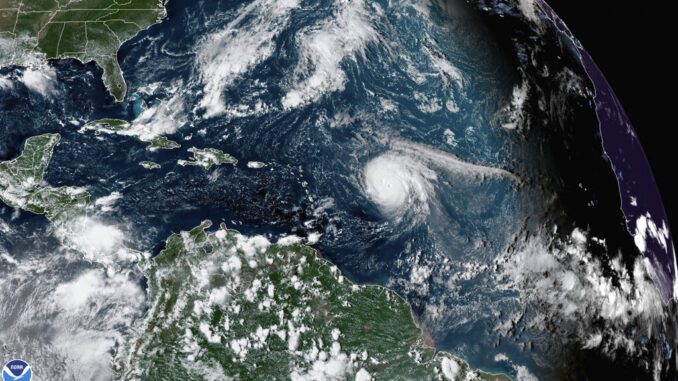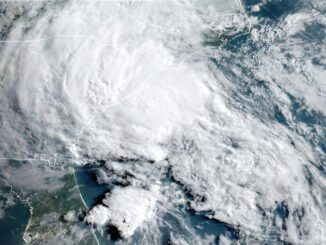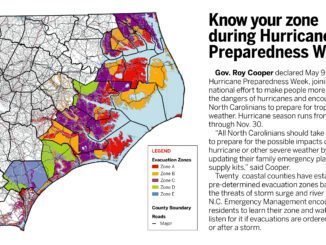
MIAMI — It’s time for residents along the southeastern U.S. coastlines to make sure their storm plans are in place as the 2023 Atlantic hurricane season is underway.
Forecasters are predicting a “near-normal” season, but Mike Brennan, the new director at the National Hurricane Center in Miami, stressed during a news conference that there’s really nothing normal when it comes to hurricanes.
“A normal season might sound good in comparison to some of the hurricane seasons in the past few years,” he said. “But there’s nothing good about a near-normal hurricane season in terms of activity.”
WILL THE 2023 ATLANTIC HURRICANE SEASON BE BUSY?
Uncertainty is the key word, Brennan said.
The National Oceanic and Atmospheric Administration predicted in late May a 40% chance of 2023 being a near-normal hurricane season, a 30% chance of an above-average season, which has more storms than usual, and a 30% chance of a below-normal season, which has fewer.
“So we’re expecting a busy season with 12 to 17 named storms,” Brennan said, adding that five to nine of those storms could become hurricanes, with one to four growing into major hurricanes.
“It only takes one storm affecting your area to make it a busy season for you,” he said.
WHAT’S NEW THIS SEASON?
This year, the hurricane center is rolling out a new storm surge model that Brennan said “helps push real-time storm surge prediction out to 72 hours in advance of the storm” in hopes of getting life-saving information to emergency managers regarding evacuation orders.
In addition, tropical weather outlooks have been extended from five days out to seven days, providing “an additional heads up” for residents to make decisions about whether to evacuate in advance of a storm, Brennan said.
WHAT IS EL NINO? HOW WILL IT AFFECT THE 2023 SEASON?
El Nino is a natural temporary warming of the Pacific Ocean that occurs every few years, changing weather patterns worldwide.
Generally, the Atlantic is quieter and has fewer storms during El Nino years. That’s because the warmer waters of El Nino make warmer air over the Pacific reach higher into the atmosphere and affect wind shear that could head off storms.
Brennan noted there are other factors that add to the uncertainty of the effects of El Nino, such as very warm sea surface temperatures, weaker low-level easterly flows and a more active African monsoon season.
“So these forces are going to kind of fight it out over the course of this hurricane season,” Brennan said. “We don’t know how this season’s going to play out.”
WHAT IS THE FEDERAL EMERGENCY MANAGEMENT AGENCY’S ROLE?
FEMA Director Deanne Criswell said her agency is working to protect residents in hurricane zones by getting them the “critical information that they need” and making it easier for people to apply for help.
She said the summer doesn’t just bring the start of hurricane season, but it’s also the beginning of wildfire season.
“So we are in the summer season of severe weather events, but I think as many of you know, it’s not just a summer season of severe weather anymore,” she said, noting weather-related events take place throughout the year.
WHY DO HURRICANES HAVE NAMES? WHEN ARE THEY RETIRED?
Hurricanes are named primarily to eliminate confusion if there are two or more storm systems occurring at the same time.
The United States began using female names for storms in 1953 and began alternating male and female names in 1978.
There is a rotating list of Atlantic hurricane season names every six years. The list can then be repeated, with names being eliminated if they are retired from the rotation, according to the National Hurricane Center’s website.
The 2023 hurricane names are: Arlene, Bret, Cindy, Don, Emily, Franklin, Gert, Harold, Idalia, Jose, Katia, Lee, Margot, Nigel, Ophelia, Philippe, Rina, Sean, Tammy, Vince and Whitney.
Hurricane names are routinely retired if a storm was so deadly or caused so much destruction that using the name again would be inappropriate. It’s not up to the National Hurricane Center to retire a name, however. That practice is left to an international committee of the World Meteorological Organization, which selects another name to replace the retired one.
The most recent names to be retired include Ian, which struck southwest Florida as a Category 5 hurricane in September 2022 with ferocious winds and storm surge as high as 15 feet. Ian killed more than 156 people in the U.S., the vast majority in Florida, according to a comprehensive National Oceanic and Atmospheric Administration report on the hurricane.
Other retired names include Katrina, Harvey, Charley, Wilma, Matthew, Michael and Irma.



